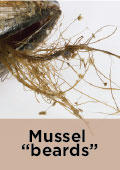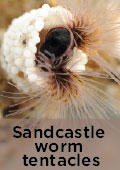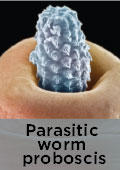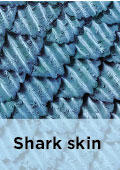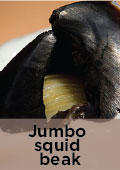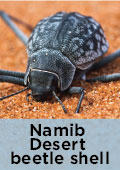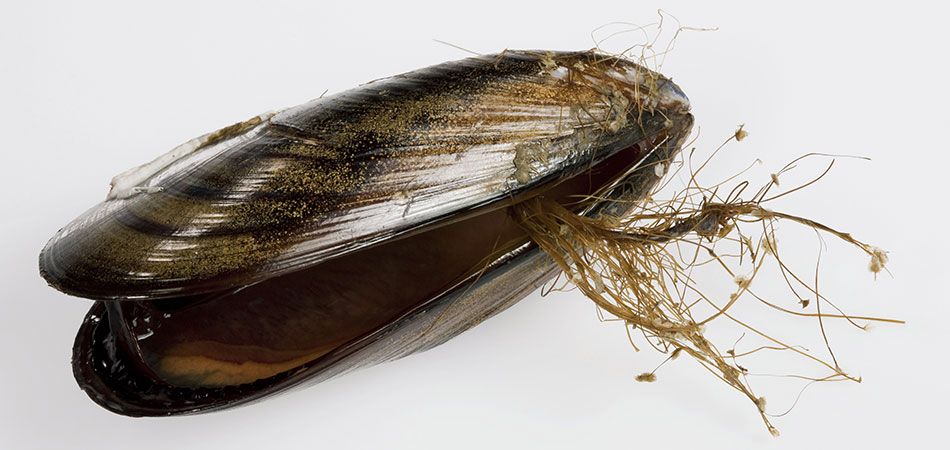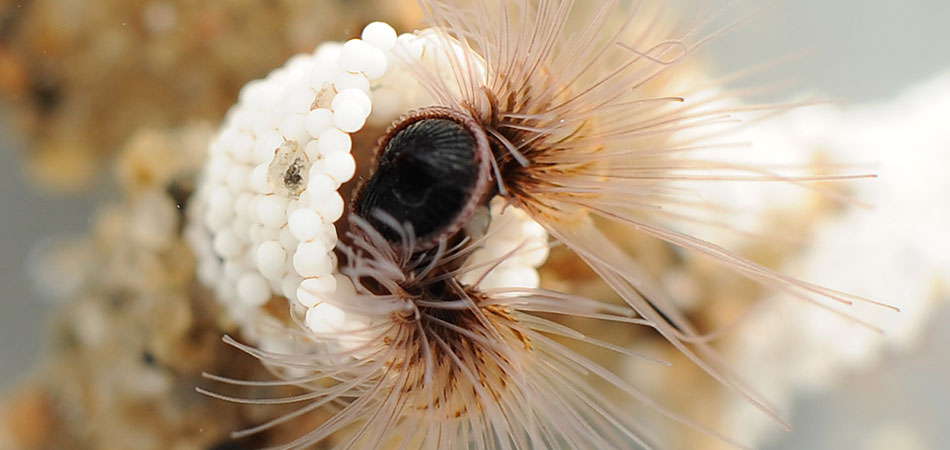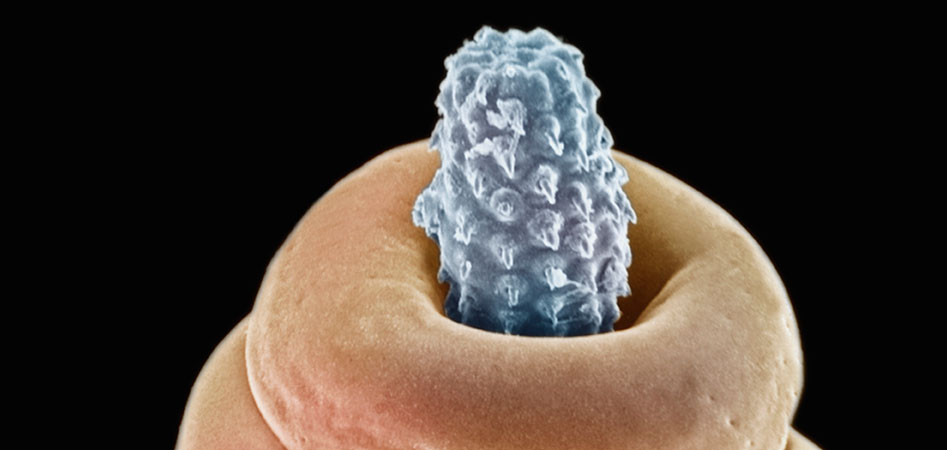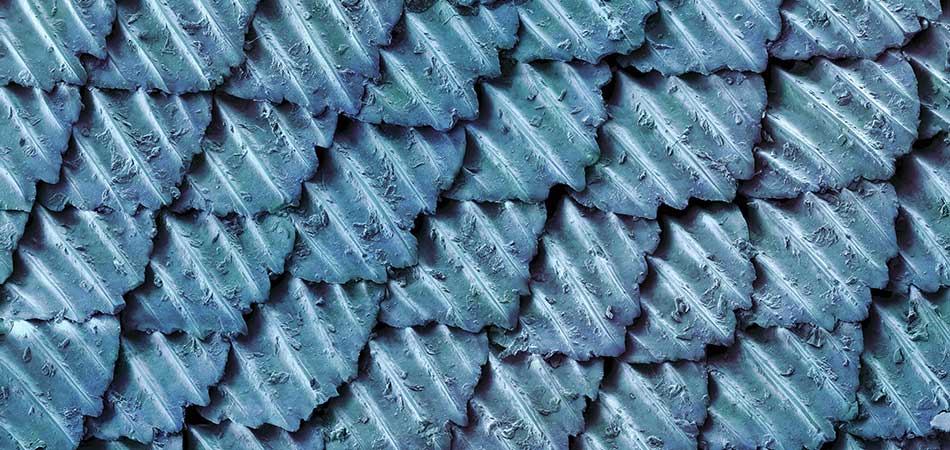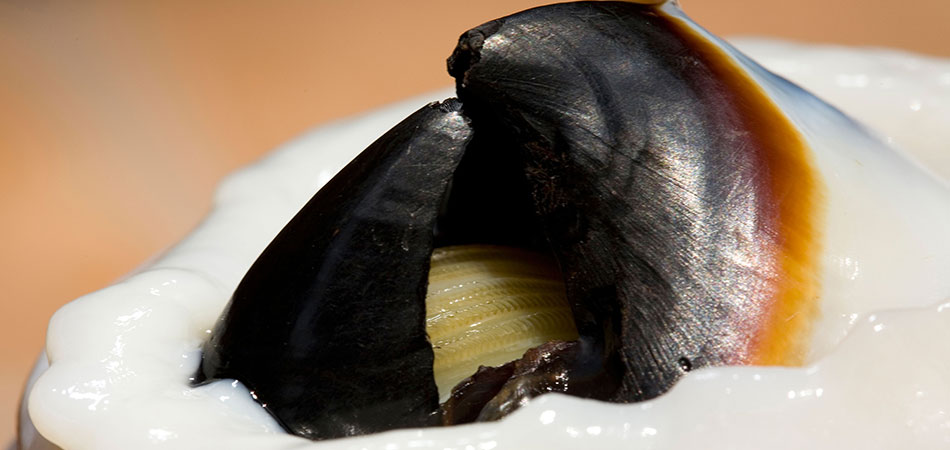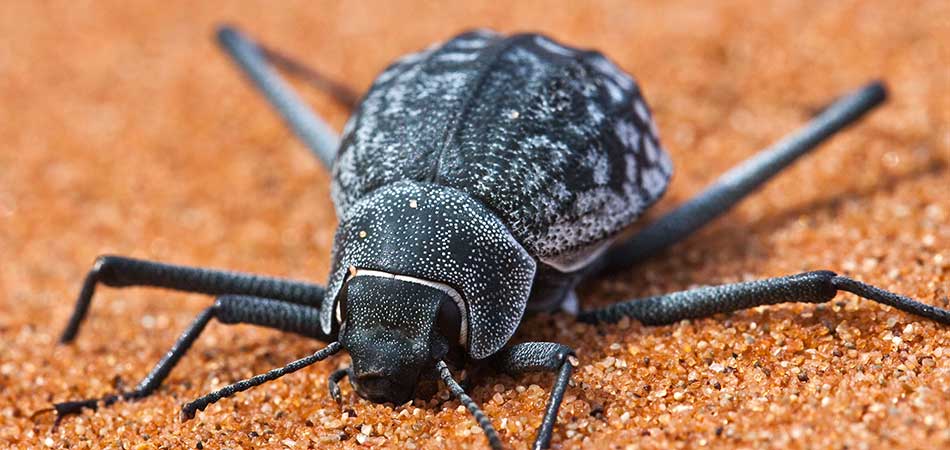BIOINSPIRATION QUIZ
Biotechnologists turn to nature for ideas about how to approach tough engineering problems. Each animal pictured below has a characteristic that has inspired a product idea listed in the center column. Can you match them up?
A glue that surgeons can apply quickly that dries instantly
A surgical adhesive for extremely delicate tissue
A drag–resistant coating for underwater robots
Microneedles that connect tissues in face transplants
A surface that efficiently collects water from fog
Hard artificial bone that can integrate into soft tissue
Mussel “beards”
Application: A surgical adhesive for extremely delicate tissue
How do mussels withstand the battering of tides and waves? The yellow “beards” that attach their shells to rocky shores, called byssal threads, contain a particular combination of hard and soft materials that are enormously resistant to dynamic force—a rare combination of stretchy and strong. Biochemists are exploring the chemistry of these sticky proteins to produce new adhesives. Their goal is a glue that could be used to seal delicate tissue, such as the amniotic sac around a fetus after in utero surgeries. Fetal membranes heal poorly, and suturing doesn’t always work.
Sandcastle worm tentacles
Application: A glue that surgeons can apply quickly that dries instantly
It’s difficult to seal tissue leaks, attach devices, and join tissues during minimally invasive surgeries, which are performed through tiny incisions. Tissue glues are a promising alternative to sutures and staples, but it’s not easy to get non-diluted glue through a small tube and into just the right location. The sandcastle worm, which lives in intertidal zones off the coast of California, sticks to wet surfaces by releasing a “burst” of granules through tiny tubes, where a chemical reaction with seawater turns them into powerful glue. Engineers who studied the worm have developed a glue that’s enclosed in tiny particles that can be easily injected through a needle, works when wet, and is activated by light.
Parasitic worm proboscis
Application: microneedles for delicate operations like face transplants
The spiny-headed worm sticks its proboscis (mouthpart) into a fish’s intestinal wall and inflates the tip, which mechanically locks the parasite into place. Scientists have developed a skin graft covered in microneedles that imitate the worm’s proboscis. When the graft makes contact with the water in natural tissues, a chemical in the tips—the same stuff that sucks up liquid in disposable baby diapers—swells up. This closes the gap between tissues, which prevents infection, and the smaller needles are less painful than surgical staples or tacks.
Shark skin
Application: A drag–resistant coating for underwater robots
Shark skin is covered with tooth-like scales called denticles that make it rough like sandpaper. Scientists long suspected that the denticles also help sharks swim and maneuver faster, by disrupting the flow of water around the fish and reducing drag. Using a micro-CT scanner and 3-D printing, they created artificial shark skin, attached it to a surface that flexed like a fish, and proved that the surface did indeed reduce the energy it takes to move through water. Artificial sharkskin could coat underwater robots, or be used on land to make rudders, airplane wings, fans, and wind turbines more efficient.
Jumbo squid beak
Application: artificial jawbone
The beak of the jumbo squid is incredibly tough—twice as hard and twice as stiff as the most competitive manufactured equivalents. It’s also an unusual combination of hard and soft, changing from extremely hard at the tip to soft where it meets the tissue of the squid’s mouth. A big challenge in creating artificial bone is to engineer both hard and soft material, so the bone can integrate with the soft tissue it connects to. Scientist hope that bioengineered bone with a hard-to-soft gradient like the squid beak’s could be used in surgeries like jawbone reconstruction.
Namib Desert Beetle shell
Application: A surface that efficiently collects water from fog
In the foggy dawn along the coast of the Namibian desert, the Stenocara beetle tilts its bump-covered shell into the wind. Water condenses on the bumps, which are superhydrophilic (water-attracting). The precious droplets then run down the beetle’s back, which is superhydrophobic (water-repelling) and into the beetle’s mouth. Using inkjet printing technology, scientists have devised a surface that mimics the beetle’s shell and efficiently collects water from fog in areas where morning fog is abundant and rainfall is scarce.
You did it!
Most of these products have yet to be developed and tested, and although some may never be realized, many others have yet to be dreamed up. All show what can happen when human imagination taps into the engine of natural selection.
Learn about developed bioinspired ideas in
this article
